Birding Around Springfield, OH – Part 1
We had good birding weather when we were in and around Dayton. Partly sunny to sunny days in the high 70’s with low humidity. That has changed. The temperatures and humidity are both climbing. Skies are cloudy and sometimes stormy.
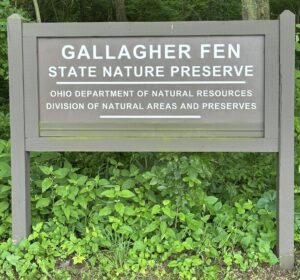
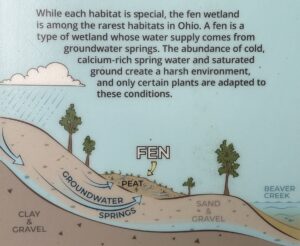
Gallagher Fen State Nature Preserve, Springfield, OH. 4709 Old Columbus Rd.
https://ohiodnr.gov/go-and-do/plan-a-visit/find-a-property/gallagher-fen-state-nature-preserve
We stayed at a hotel in Springfield. The drive to Gallagher Fen was lovely. Farming country and well-paved roads with little traffic. You can use your GPS, but be aware that ours took us to the private driveway of a house which turned out to be about a quarter of a mile away from the nature preserve entrance drive. We did keep going, but then we drove past the entrance – there is no sign on the highway to mark where you turn to drive into the small parking lot. Even though this was a bit more difficult to actually locate than all the other areas we birded, it was well worth the effort. Gallagher Fen is a great place for walking and birding. It is open every day 30 minutes before sunrise. Great for birders and photographers! And a note – pets on leashes were permitted in all the places we visited in and around Dayton – they are not permitted here.
There is one trail which is about a mile long. When you reach the end, you can go either direction – both are short loops. In one direction is a small pioneer cemetery and in the other direction is a trail that leads through a drier oak/hickory woodland and then to a boardwalk that loops around the perimeter of one of the bowls** in the fen. Most of this state preserve is off-limits to people, but by taking this boardwalk, you will see one of the fens with all if its wildflowers and beauty.
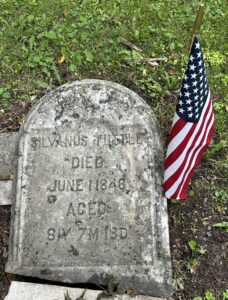
As we were walking, the weather started to deteriorate. Storm clouds were forming. It was hot, quite humid, and it was misting from time to time.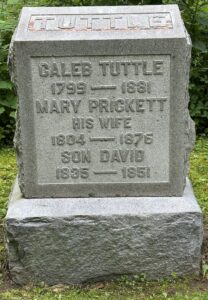 Even though we always hike with rain slickers, we decided not to take the longer option of the boardwalk loop and turned to take the short walk to the cemetery. There were about 8 or 9 tombstones – some of them broken. But you still could read a few. Most were from the mid-1800’s. This area was all neatly mowed and trimmed – the graves well tended. One family – in particular – still seems to have an interest in this cemetery.
Even though we always hike with rain slickers, we decided not to take the longer option of the boardwalk loop and turned to take the short walk to the cemetery. There were about 8 or 9 tombstones – some of them broken. But you still could read a few. Most were from the mid-1800’s. This area was all neatly mowed and trimmed – the graves well tended. One family – in particular – still seems to have an interest in this cemetery.
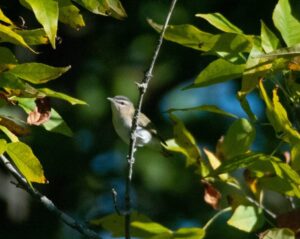
But I have not told you the best part – and this is what keeps birders moving on the trail when the weather is not cooperating. It was getting hotter, the humidity was rising, and storm clouds were forming. What cheered us on was that for the first quarter mile of the trail, we were accompanied by several Red-eyed Vireos calling back and forth to each other. If you have never heard them, try allaboutbirds.org, type in Red-eyed Vireo, and click on Listen. These birds have a 3-note song which is often described in field guides as: Look at me!, Way up here!, Here I am! Where are you?” and so on. For that first quarter mile, we were inundated with short comments and questions!
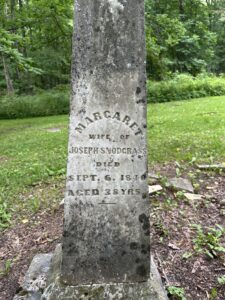
But it was the next three-quarters of a mile that totally overwhelmed me with joy. Wood Thrushes. Singing from several places throughout the woods. Calls and answers. And if you have never heard them, this is one of the most ethereal songs you will ever hear. So flutelike. Simply beautiful. And whenever I hear Wood Thrushes I can feel myself turning away from my life and becoming more attuned to everything around me. And these Wood Thrushes accompanied us all the way to the pioneer cemetery and then most of the way back to the car. Out of all the birding experiences we had so far on this trip, this meant the most to me. To hear them, go to allaboutbirds.org, type in Wood Thrush, click on Listen.
Red-eyed Vireo populations are in decline but so far, they still are a ‘Common’ bird in many woodlands. Sady, that is not the case for the Wood Thrush whose numbers are declining more rapidly. This thrush is on the Watch List of organizations that track birds. This means it is getting close to the time that without human intervention in preserving nesting areas and wintering areas, this bird could be heading towards extinction. Since the 1960’s, the Wood Thrush’s population has decreased by about 1.5% every year*.
I posted a new video and you will hear both birds – but most often the Wood Thrushes.

As we walked along the trail, lovely stands of Mayapples were along both sides. (Podophyllum peltatum). As they are spring ephemerals. they were starting to decline – when summer comes, they go dormant. But they were still lovely. If you are unfamiliar with them, each plant has 1 bloom and it is on the stem underneath the umbrella top. Each flower produces a fruit which was prized by pioneers. When I was a child, I had a friend, Jonny Belle, whose great aunt made Mayapple jam which was delicious. This jam is very difficult to make – not the actual jam making part, it is the gathering the fruit part. Possums, raccoons, skunks, squirrels and box turtles love the fruit of Mayapples and will generally get to a patch long before you do. However, do not try making this jam unless you know what you are doing or are with your wise grandmother or great grandmother who knew much more about wild plants than most of us do now. All parts of the Mayapple are toxic except the ripe fruits. Unripe fruits are green and the ripe ones are yellow. I am so thankful I had a taste of this wonderful jam when I was a child! Made by a woman who knew exactly what she was doing when she was preparing wild foods.

Touch-me-not (Impatiens capensis). The hiker’s remedy to poison ivy. When walking, if you accidently get into poison ivy, look for this plant. Crush a few leaves and stems and rub the area of your skin that came in contact with the poison ivy with the juice of this plant. It counteracts the poison ivy and will reduce or eliminate the spreading rash and that awful itching. In many places in the eastern woodlands, poison ivy and touch-me-not grow side-by-side. Mother Nature taking care of us? I have used this old remedy more than once and it works. The rash was not eliminated, but greatly reduced, did not spread, and disappeared by the next day. Touch-me-not is also called Jewelweed. Look at the photo and you will see a dot of orange – that is the first flower of the season on this group of plants. These plants are just starting their blooming period. If you touch the flower most often it will fall from the plant to the ground – hence one of its common names – touch-me-not. If you look at the entire plant you may think it looks a bit familiar????? Notice its Latin name. Impatiens. Same as the Impatiens that you grow as annuals in the shaded parts of your flower garden. These plants are related.
The trail from the parking lot through the woodland to the pioneer cemetery was well-maintained and level. Not as wet as the trail at Woodman Fen because at that fen, you were actually walking through the fen. At this fen, you are walking around the several bowls** that are fens, It was a good walk past full-grown trees with a lovely understory.
The birds we heard – this was a singing woodland!
Acadian Flycatcher Brown-headed Cowbird
Wild Turkey House Wren
Blue-gray Gnatcatcher Baltimore Oriole
Carolina Wren Downy Woodpecker
Tufted Titmouse Gray Catbird
Wood Thrush Red-winged Blackbird
Red-eyed Vireo Indigo Bunting
Northern Cardinal Eastern Wood-Pewee
White-breasted Nuthatch
*This information comes from The North American Breeding Bird Survey. For more information on this organization, and other organizations, go to this website’s menu, click on Everything Bird!, scroll to Organizations for Birds and click on that article.
** From AI on Google Chrome: “A fen bowl is a type of fen (a peat-accumulating wetland) that is specifically located within a concave-shaped depression. This distinguishes it from other types of fens, such as sloping fens, which form on hillsides.” Gallagher Fen was a fen that had several bowls. Woodman Fen was a flatter fen – the ground was much more level. No bowls.

